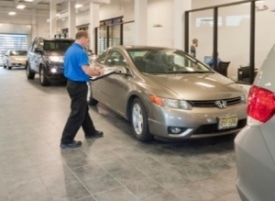WHEN you choose to lease your new car, one of the main responsibilities is keeping it in the best condition possible in time for the final handover of your end-of-contract lease car when it is inspected for damage.

While you will be let off for minor ‘wear and tear’ issues, any extensive damage can incur costs when the car is inspected at the end of the contract period.
During the inspection, any detectable damage will be flagged and you will receive an invoice for the repair costs.
The wear and tear that should be overlooked is laid out in the BVRLA’s Fair Wear and Tear guide used by all good dealerships, finance houses, and brokers when inspecting cars for collection.
What is usually acceptable includes:
- Scratches of up to 25mm except where primer or bare metal is exposed
- Scratches that don’t interrupt the driver’s line of sight
- Scuffs of up to 25mm on alloys
- Tyres must meet UK legal requirements
- Light staining to the driver’s seat area
- Lens damage where there is no broken glass and no water ingress
Unacceptable damage includes:
- Unrepaired crash damage
- Unclean interior or exterior that renders inspection impossible
- Adhesive residue
- Windscreen chips
- Wheel damage due to kerbing
- Scratches and abrasions longer than 25mm
What will damage cost to fix?
How much charges could amount to is difficult to predict, as they depend upon several variables including the kind of damage done, the manufacturer of the car, and who the car is ultimately handed over to for repairs to be made.
The best course of action is always to make sure any necessary repairs are carried out before the inspection. This gives you the chance to shop around for the best deal, whereas the leasing company is likely to pay whatever is necessary to fix the damage no matter the cost as this will be passed back to the client.
However, it is always best to get the vehicle fixed by the relevant manufacturer’s garage to ensure any work done meets the manufacturer’s guidelines and you avoid any additional charges. Third party garages can be used, but we would advise that this is done at the driver’s own risk.
Avoiding charges for damage to end-of-contract lease car
To avoid shelling out for additional costs that you hadn’t factored into the leasing deal, we would always recommend getting any damage fixed ahead of time. It’s also well worth photographing the car from all angles possible, including each panel, wheel, and interior section before the car is collected from you.
Images should have a time stamp (either digital or visible on the image itself) that verifies the visible damage coincides with the day the car is collected from you. Images such as these can be used either to prove there was no damage to the car at the point of collection, or that only a certain level of damage was visible.
Helpful hint: When handing your lease car back for inspection, firstly give it an inspection of your own. Think of the car as though you were looking to buy it in used condition, and if there is anything that you would flag to the seller yourself then it would be best to get it fixed.
This post was put together by the guys over at Vantage Leasing, who are UK-based car leasing specialists. If you would like to know about leasing a car, then visit them via the link and speak to one of the team. Vantage specialise in car leasing and can offer a competitive lease deal across a range of prestigious vehicles.







